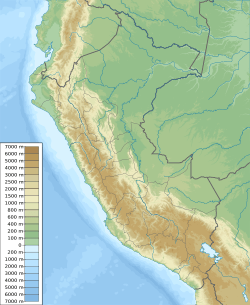Quriwayrachina, La Convención facts for kids
| Location | Peru, Cusco Region, La Convención Province |
|---|---|
| Region | Andes |
| Coordinates | 13°20′30″S 72°53′19″W / 13.34167°S 72.88861°W |
| History | |
| Cultures | Inca |
Quriwayrachina (pronounced Koo-ree-why-rah-CHEE-nah) is an ancient Inca settlement. Its name comes from the Quechua language. Quri means gold, and wayrachina is a special oven. So, Quriwayrachina means "oven for smelting gold."
This old Inca town was found in 2001. It is located in the Willkapampa mountains in the Cusco Region of Peru. The site is in the Santa Teresa District of the La Convención Province. It sits on a mountain called Victoria.
Quriwayrachina is north of the famous Choquequirao site. It is also west of the mountains Kiswar and Quriwayrachina. The area around it has many old Inca mines. The hills are covered with stones from over 200 buildings. These buildings were part of this important Inca outpost.
Discovering Quriwayrachina
A British photographer named Peter Frost first found a walking trail to the village in 1999. He was exploring the area. In June 2001, he led a team of archaeologists to the site. They wanted to learn more about this hidden place.
What Was Found at the Site?
The team found a large area, about 6 square kilometers (2.3 square miles). This area included many interesting things. They discovered agricultural terraces, which are like giant steps for farming. There were also places to store grain.
The archaeologists found cemeteries and grave towers. They also saw more than 100 round buildings. There was even the base of a pyramid. An 8-kilometer (5-mile) long canal was also found. This canal was used to bring water for farming.
The main religious and administrative center was an open plaza. Underneath this plaza, a tomb was located. This suggests it was a very important place for the Inca people.
What Happened to the Site?
Sadly, when the researchers arrived, the city had already been looted. This means that valuable items were taken from the site. Skeletons were found in the graves, but no grave goods were left. Grave goods are items buried with people.
The pottery and stone tools found helped experts learn about the site. They showed that the outpost was used during two different time periods. It is thought that the settlement started in the early 13th century. It was then left empty for a while. Later, people came back and settled there again.
See also
 In Spanish: Corihuayrachina para niños
In Spanish: Corihuayrachina para niños


